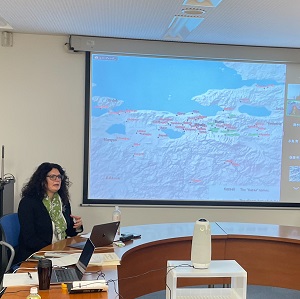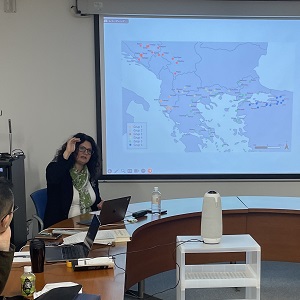Report
On February 16, 2024, the Tobuken Seminar "Forged in Battle: A Comparative Examination of Boyhood Transformation in the Devşirme System" was held at IASA, the University of Tokyo. Professor Gülay Yılmaz of Akdeniz University, who specializes in the history of the Ottoman janissaries, and had been in Japan since January under the JSPS program of Invitational Fellowships for Research in Japan, gave a lecture on the devşirme or janissary recruitment system from a comparative perspective. Professor Yılmaz first examined how boys were recruited in the early 17th century based on the devşirme registers, and then discussed how the training process and the beliefs of the Bektaşi order influenced the formation of the warrior identity, citing poems written by janissaries and making comparisons with Japanese samurais.
There were 14 participants in person and 13 online. During the Q&A session, questions were asked about the areas where the conscription took place, the place of horsemanship in the training, the conscription of Jews, and other topics. There were also questions about the practice of working with Turkish farmers, with a discussion of whether the ties to their host families continued afterward, and whether the janissaries had special feelings about the days with Turkish farmers.
 |
 |
Event Details:
Date and time: February 16, 2024 (Fri), 4:30pm~6:15pm
Venue: Institute for Advanced Studies on Asia, 2nd Meeting Room (302)/Zoom
Speaker: Gülay Yılmaz (Akdeniz University)
Title: Forged in Battle: A Comparative Examination of Boyhood Transformation in the Devşirme System
Chair: Jun Akiba (IASA, U Tokyo)
Lecture Abstract:
This presentation begins on the devşirme system as a recruitment method, focusing on the selection strategies employed for boys and how they evolved from the fourteenth to the early seventeenth century. The second aspect of the investigation delves into the training process for boys transitioning into warriors. This inquiry encompasses traditional weapons training, assimilation into communal life within the barracks, and the reshaping of self-perception through concepts of prowess, brotherhood, and martyrdom. The presentation analyzes the intricate interplay between religious beliefs, martial training, and the construction of masculine identities. It focuses on iconic warrior groups including the janissaries, Japanese samurais, Knights Hospitalliers of Rhodes, and Mamluk warriors, drawing parallels in their experiences as professional soldiers from the medieval era to early modern era.
